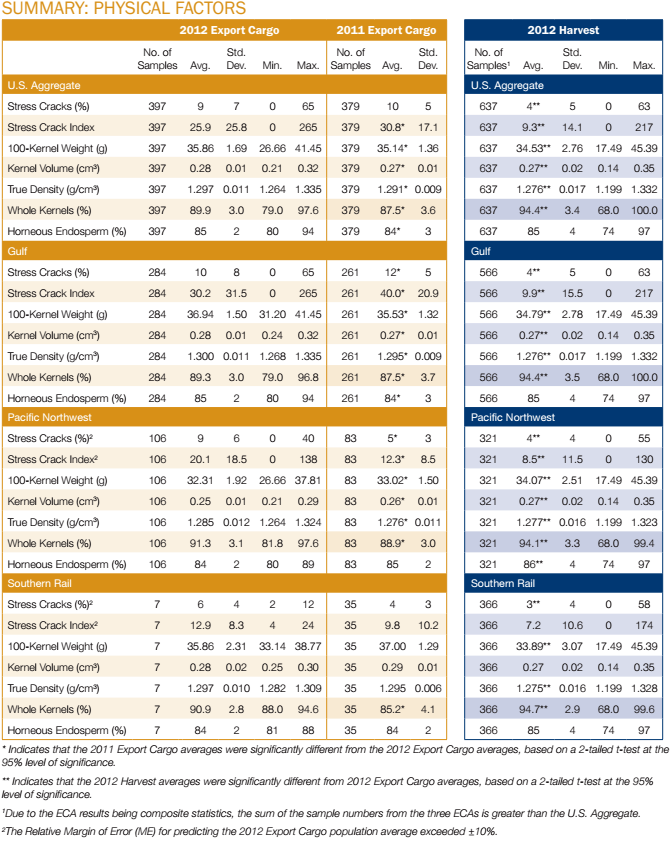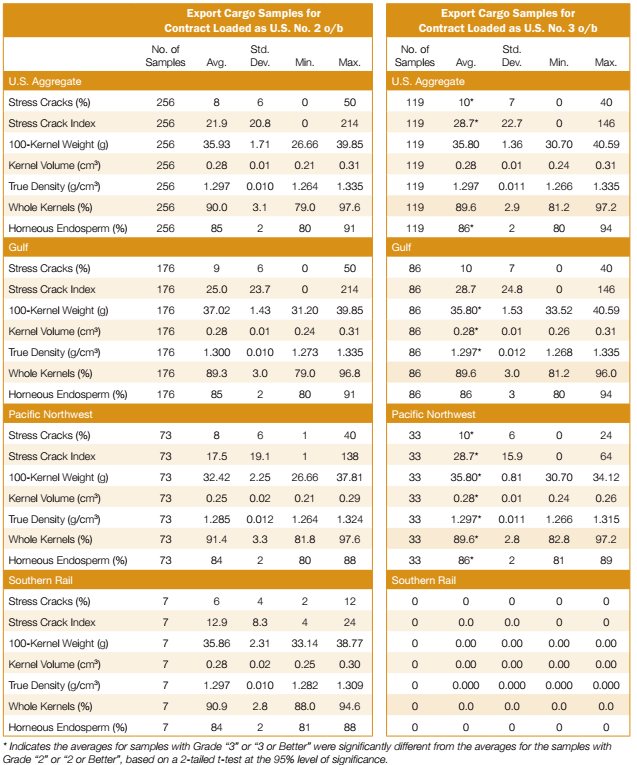D. Physical Factors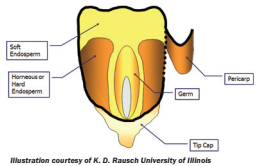
Other physical attributes of corn kernels also affect corn’s processability, storability and ability to withstand handling. Physical factors such as stress cracks, kernel weight, volume and density, percent whole kernels and percent horneous (hard) endosperm are influenced by genetics as well as by growing and handling conditions. Corn kernels are made up of four parts, the germ or embryo, the tip cap, the pericarp or outer covering, and the endosperm. The endosperm represents about 82% of the kernel and consists of soft (also referred to as floury or opaque) endosperm and horneous (also called hard or vitreous) endosperm as shown to the right. The endosperm contains primarily starch and protein, the germ contains oil and some proteins, and the pericarp and tip cap are mostly fber.
SUMMARY: PHYSICAL FACTORS
- The low levels of stress cracks (9%) in the 2012/13 export samples indicate good potential for reduced rates of breakage when corn is handled, improved wet milling starch recovery, improved dry milling yields of flaking grits, and good alkaline processability.
- Kernel true densities (1.297 g/cm3) were higher for export samples than harvest samples. For the export samples, 95% had kernel true densities equal to or above 1.275 g/cm3, which was higher than the 88% found in 2011/12. Both true densities and test weights were significantly higher for the 2012/13 export samples than for the 2011/12 export samples.
- The relatively high whole kernels (89.9%) in combination with the low stress cracks (9%) at export indicate the corn should have reduced breakage during loading and discharge of the cargo.
- Kernel volumes and 100-kernel weights were significantly higher for the 2012/13 export samples than for the 2011/12 export samples, indicating slightly larger kernel sizes in 2012/13 corn exports.
1. Stress Cracks and Stress Cracks Index (SCI)
Stress cracks are internal fssures in the horneous (hard) endosperm of a corn kernel. The pericarp (or outer covering) of a stress-cracked kernel is typically not damaged, so the outward appearance of the kernel may appear unaffected at first glance even if stress cracks are present.
The cause of stress cracks is pressure buildup due to moisture and temperature differences within the kernel’s horneous endosperm. This can be likened to the internal cracks that appear when an ice cube is dropped into a lukewarm beverage. The internal stresses do not build up as much in the soft, floury endosperm as in the horneous endosperm; therefore, corn with higher percentages of horneous endosperm is more susceptible to stress cracking than softer grain. Stress cracks affect corn in various ways:
- In general – Increased susceptibility to breakage during handling, leading to increased broken corn needing to be removed during cleaning operations for processors, and possible reduced grade/value.
- Wet Milling – Lower starch yield because the starch and protein are more difficult to separate. Stress cracks may also alter steeping requirements.
- Dry Milling – Lower yield of large flaking grits (the prime product of many dry milling operations).
- Alkaline Cooking – Non-uniform water absorption leading to overcooking or undercooking, which affects the process balance.
High-temperature drying is the most common cause of stress cracks. Growing conditions affect the need for artificial drying and influence the degree of stress cracking found from region to region. Then, as corn moves through the market channel, some stresscracked kernels break, increasing the proportion of broken corn. Concurrently, impacts of kernels on other kernels or on metal during handling may cause new cracks in kernels. As a result, the percentage of kernels with stress cracks may not remain constant through the merchandising channel.
Stress crack measurements include “stress cracks” (the percent of kernels with at least one crack) and stress crack index (SCI) which is the weighted average of single, double and multiple stress cracks. “Stress cracks” measures the number of kernels with stress cracks whereas SCI shows the severity of cracking. For example, if half the kernels have only single stress cracks, “stress cracks” is 50% and the SCI is 50 (50 x 1). However, if half of the kernels have multiple stress cracks (more than 2 cracks), indicating a higher potential for handling issues, “stress cracks” remain at 50% but the SCI becomes 250 (50 x 5). Lower values for “stress cracks” and the SCI are always better. Multiple stress cracks are generally more detrimental to quality changes than single stress cracks.
HIGHLIGHTS
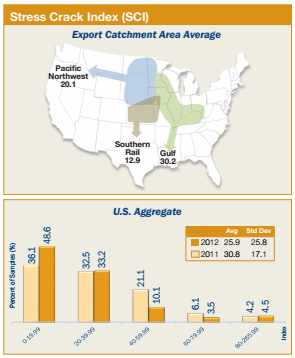
- The relatively low levels of stress cracks observed for 2012 corn should indicate reduced rates of breakage when corn is loaded and discharged, improved wet milling starch recovery, improved dry milling yields of flaking grits, and good alkaline processability.
- U.S. Aggregate stress cracks in the 2012/13 export samples was 9%, not significantly different from the 2011/12 export samples (10%).
- Stress cracks at export was higher than the stress cracks found at harvest (4%) but was still at a very low level.
- Stress cracks ranged from 0 to 65% with a standard deviation of 7%.
- About 91% of the export samples had less than 20% of their kernels with stress cracks. While this was lower than the 97% of the harvest samples with less than 20% stress cracks, it indicates the corn should still handle very well with relatively low amounts of breakage.
- Stress crack percentages for contracts loaded as U.S. No. 2 o/b were 8%, significantly lower than the 10% in contracts loaded as U.S. No. 3 o/b.
- SCI average of 25.9 in 2012/13 export samples was lower than the 30.8 found with the 2011/12 export samples. At export, 82% of the samples had SCI of less than 40, indicating relatively few kernels had double or multiple stress cracks.
- U.S. Aggregate SCI for contracts loaded as U.S. No. 2 o/b were 21.9, significantly lower than the 28.7 found for contracts loaded as U.S. No. 3 o/b.
2. 100-Kernel Weight
100-kernel (100-k) weight (reported in grams) indicates larger kernel size as 100-k weights increase. Large kernels may take longer to dry than smaller kernels and large uniform-sized kernels often enable higher flaking grit yields in dry milling. Kernel weights tend to be higher for varieties with high amounts of horneous endosperm.
HIGHLIGHTS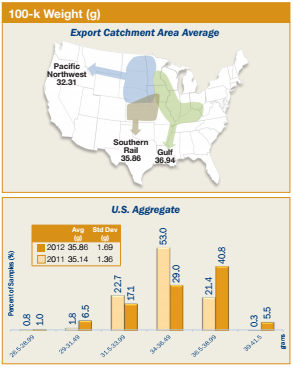
- 100-k weight averaged 35.86 g for U.S. Aggregate export corn with a range of 26.66 to 41.45 g. The export samples had greater uniformity than the harvest level corn as indicated by a tighter range and lower standard deviation.
- The 100-k weights were lower for the Pacific Northwest ECA with 32.31 g than the Gulf or Southern Rail ECAs.
- About 46% of the 2012/13 export samples had 100-k weights of 36.5 g or greater, which was much higher than the 2011/12 export samples (22%).
3. Kernel Volume
Kernel volume in cubic centimeter (cm3) is often indicative of growing conditions. If conditions are dry, kernels may be smaller than average. If drought hits later in the season, kernels may have lower fill. Small or round kernels are more difficult to degerm. Additionally, small kernels may lead to increased cleanout loss for processors and higher yields of fber.
HIGHLIGHTS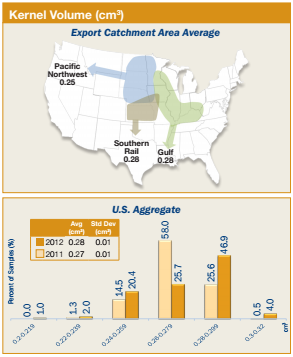
- Kernel volume averaged 0.28 cm3 for U.S. Aggregate 2012/13 export samples, higher than the 0.27 cm3 found in the 2011/12 export samples. Kernel volume ranged from 0.21 to 0.32 cm3.
- The range and standard deviations were less in the 2012/13 export samples than for the 2012 harvest samples, indicating greater uniformity.
- The kernel volumes were smaller (0.25 cm3) for the Pacific Northwest than for the Gulf and Southern Rail ECAs (0.28 cm3).
- About 77% of the export samples had kernel volumes equal to or greater than 0.26 cm3.
4. Kernel True Density
Kernel true density is calculated as the weight of a 100-k sample divided by the volume, or displacement, of those 100 kernels and is reported as g/cm3. True density is a relative indicator of kernel hardness, which is useful for alkaline processors and dry millers. True density may be affected by the genetics of the corn hybrid and the growing environment. Corn with higher density is typically less susceptible to breakage in handling than lower density corn, but it is also more at risk for the development of stress cracks if high-temperature drying is employed. True densities above 1.30 g/cm3 would indicate very hard corn desirable for dry milling and alkaline processing. True densities near the 1.275 g/cm3 level and below tend to be softer, but will process well for wet milling and feed use.
HIGHLIGHTS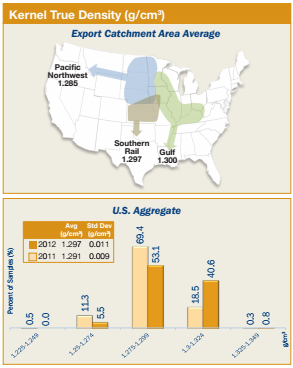
- Kernel true densities averaged 1.297 g/cm3 for U.S. Aggregate export corn, significantly higher than the 1.291 g/cm3 found in 2011/12 exports.
- Kernel true densities at export were higher than the 1.276 g/cm3 found for harvest corn. This apparent increase in true density is likely due in part to lower moisture at export (14.2% compared to 15.3% for harvest samples) and because true density tests were performed on only whole, fully intact kernels.
- For the export samples, 95% had kernel true densities equal to or above 1.275 g/cm3, which was higher than the 88% found in 2011/12.
- Among ECAs, Pacific Northwest with 1.285 g/cm3 had the lowest average true density among ECAs. The Gulf and Southern Rail ECAs had significantly higher kernel densities than the Pacific Northwest ECA.
5. Whole Kernels
Though the name suggests some inverse relationship between whole kernels and BCFM, the whole kernels test conveys different information than the broken corn portion of the BCFM test. Broken corn is defined solely by weight percentage of material passing through a screen. Whole kernels, as the name implies, is the percent of fully intact kernels in the sample that have their pericarp fully intact.
The exterior seedcoat or pericarp of the corn kernel is very important for two key reasons. First, any breaks in the kernel pericarp affect water absorption for alkaline cooking operations. Kernel nicks or cracks allow water to enter the kernel faster than for fully intact or whole kernels. Too much water uptake during cooking can result in expensive shutdown time and/or products that do not meet specifications. Secondly, intact whole kernels are less susceptible to mold invasion during storage and to breakage during handling. Some companies pay extra premiums for contracted corn delivered above a specified level of whole kernels.
HIGHLIGHTS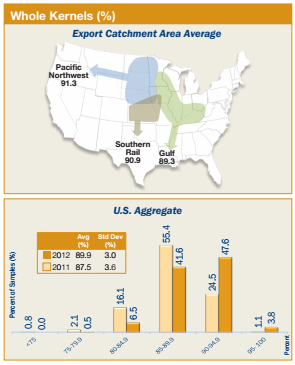
- U.S. Aggregate whole kernels averaged 89.9%, and was higher than in the 2011/12 export samples (87.5%).
- The percent of whole kernels at export was lower than whole kernels found at harvest (94.4%).
- Whole kernel averages for Gulf, Pacific Northwest, and Southern Rail were 89.3%, 91.3%, and 90.9%, respectively.
- Over half (51%) of the 2012/13 export samples had whole kernel percentages greater than or equal to 90%, compared to 26% of the 2011/12 export samples.
- The whole kernel percentages for contracts loaded as U.S. No. 2 o/b were 90.0%, essentially the same as those found for contracts loaded as U.S. No. 3 o/b.
6. Horneous (Hard) Endosperm
The horneous (hard) endosperm test measures the percent of horneous or hard endosperm out of the total endosperm in a kernel, with a potential value from 70 to 100%. The greater the amount of horneous endosperm relative to soft endosperm, the harder the corn kernel is said to be. The degree of hardness is important depending on the type of processing. Hard corn is needed to produce high yields of large flaking grits in dry milling. Mediumhigh to medium hardness is desired for alkaline cooking. Moderate to soft hardness is used for wet milling and livestock feeding.
Hardness has been correlated to breakage susceptibility, feed utilization/efficiency and starch digestibility. There is no good or bad value for horneous endosperm; there is only a preference by different end users for particular ranges. Many dry millers and alkaline cookers would like greater than 90% horneous endosperm, while wet millers and feeders would typically like values between 70% and 85%.
HIGHLIGHTS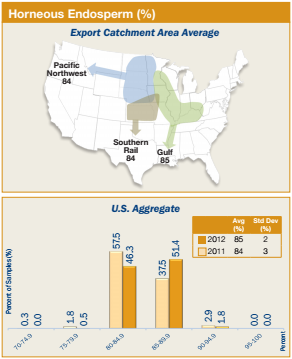
- U.S. Aggregate horneous endosperm averaged 85% and was higher than the 84% found for the 2011/12 export samples. The 2012/13 export samples ranged from 80 to 94% and had a smaller range and standard deviation than the 2012 harvest samples.
- Horneous endosperm averages ranged between 84% and 85% among the ECAs.
- Horneous endosperm percentages were lower (85%) for contracts loaded as U.S. No. 2 o/b than those loaded as U.S. No. 3 o/b (86%).
- At the export, 99.5% of the samples had greater than 80% horneous endosperm in contrast to harvest samples where 86.7% had greater than 80% horneous endosperm.
